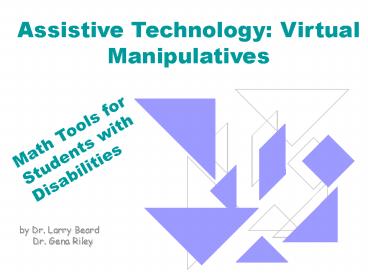Assistive Technology: Virtual Manipulatives - PowerPoint PPT Presentation
1 / 24
Title:
Assistive Technology: Virtual Manipulatives
Description:
Just as building blocks are necessary for a preschool child, technology is a ... Utilize rental and loaner. resources. Learn it before using it. Set timelines ... – PowerPoint PPT presentation
Number of Views:61
Avg rating:3.0/5.0
Title: Assistive Technology: Virtual Manipulatives
1
Assistive Technology Virtual Manipulatives
Math Tools for Students with Disabilities
by Dr. Larry Beard Dr. Gena Riley
2
Assistive Technology A Necessary Tool for
Students with Disabilities
"Keep an open mind about the use of technology in
the classroom. Just as building blocks are
necessary for a preschool child, technology is a
necessary tool for students with learning
disabilities to assist them with overcoming their
academic challenges." --Jane Quenneville
3
- The number of students with disabilities
receiving their education in the general
education classroom is increasing because of a
number of factors.
- Foremost was the action by congress to increase
the rights of people with disabilities through
the implementation of several pieces of key
legislation.
4
- As far back as 1973, Section 504 of the
Rehabilitation Act mandated that agencies
receiving federal funds (and virtually all
schools do) must provide equal access to their
facilities, programs and services.
- Even though equal access was the law of the land,
little progress was actually made.
5
- The Individuals with Disabilities Education Act
(IDEA), originally enacted as P.L. 94-142, levied
the mandate on public schools (through the 12th
grade or age 21) to provide a free and
appropriate public education in the least
restrictive environment.
- Moving students with disabilities out of
restricted placements and into regular classrooms
with appropriate support and assistive technology
has generated a whole new group of students that
are ready to compete at the college level.
6
- The Technology Related Assistance for Individuals
with Disabilities Act of 1988 (Tech Act)
emphasized the importance of equal access for all
individuals. - Assistive technology is defined as any off the
shelf or specially designed item, equipment,
product or service that increases, maintains, or
improves the function of individuals with
disabilities. - Assistive technology allows individuals with
disabilities to have greater control over their
lives and to participate in more activities.
7
- While classrooms do not have to change essential
curriculum components, reasonable accommodations
for the student with a disability must be made.
- Assistive technology can be used to make these
accommodations.
8
Assistive Technology A Necessary Tool for
Students with Disabilities
- For students with learning disabilities
technology can be - an assistive tool replacing an ability
- that is either missing or impaired
- provides the support needed
- to accomplish a task
9
Assistive Technology
- Assistive Technology serves two major purposes
- to augment an individuals
- strengths, thereby
- counterbalancing the effects
- of the disability
- provide an alternative mode
- of performing a task
10
Functional Assessment Process (FAP)
- NOT specific to one particular
- area of assistive technology
- INSTEAD, use as a guideline
- for overall intervention
11
Step One Intake/referral
- Student referred for services
- General screening for possible
- problems
12
Step Two Identification of needs
- Specific to the device
- Goals
- Interests
- Dislikes
- Priorities
- Practical aspects of living
- situation
13
Step Three Identification of desired outcomes
- Assistive technology needs
- Environments where it will
- be used
- Any assistive technology
- previously used and outcomes
14
Step Four Develop and nurture team members
- Flexible
- Collaborative
- Parents
- Teachers
- Peers/friends
- Repeatedly revise decisions
- Needs change
- Abilities change
- Expectations change
- Develop roles and responsibilities
- Action items
- List members
- Decide on primary and supportive roles
15
Step Five Skills assessment
- Sensory
- Physical
- Cognitive skills
- Communication
- SETT framework
- Skills
- Environment
- Tasks
- Tools
16
Step Six Product trials
- Negotiate what to try
- Set up product trials
- Utilize rental and loaner
- resources
- Learn it before using it
- Set timelines
17
Step Seven Revisit desired outcomes
- Determine if needs changed
- Determine if skills changes
18
Step Eight Obtain product
- Obtain funding
- Beg, borrow, download
19
Step Nine Technology implementation
- Train student to use the product
- Evaluate training
20
Step Ten Follow Up/Follow Along
- Systematic follow up
- Follow along as long as
- student need assistive
- technology products
21
In Inclusive Classrooms
- Technology
- fosters belonging and interactive participation
in the general - education classroom
- increases the frequency of
- assignment completion
- contributes to improved
- motivation
22
In Inclusive Classrooms
- Technology
- can ease frustration
- increase motivation
- foster a sense of peer
- acceptance
- improve productivity in the
- classroom and at home
23
What are Virtual Manipulatives?
- Manipulatives modeled after concrete
manipulatives commonly used in schools, such as,
pattern blocks, geoboards, tangrams, base ten
blocks, and fraction models.
24
Virtual Manipulatives
- allow the user to engage and control the physical
action of the object - gives opportunity to discover and construct
mathematical principles and relationships































